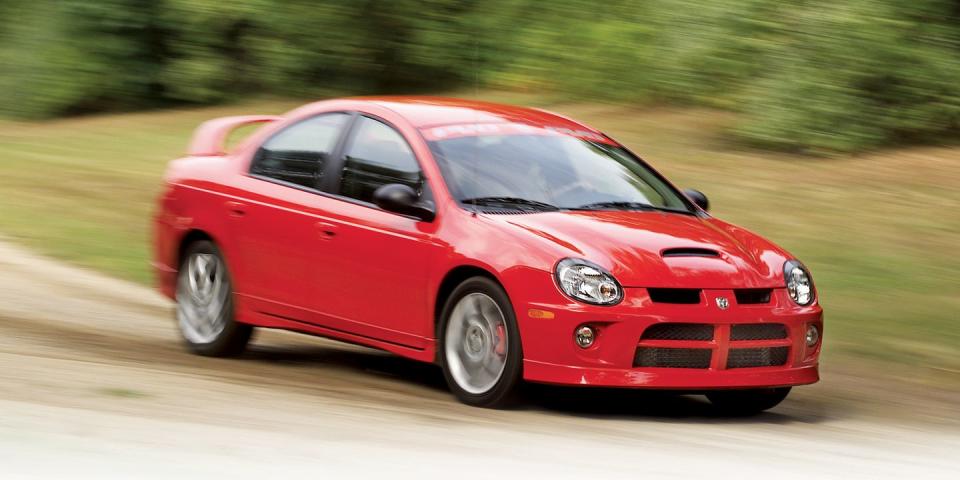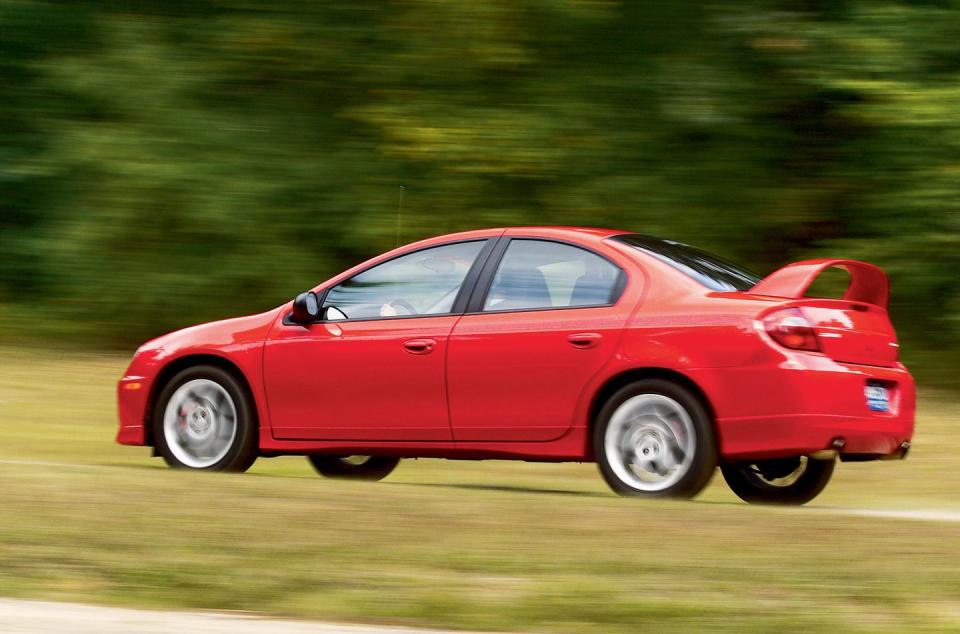Tested: 2003 Dodge Neon SRT-4 Goes Big on Power, Easy on Price

From the December 2002 issue of Car and Driver.
One look reveals the probable character of the beast, so let's just cut right to the quick. The Neon SRT-4 rips to 60 mph in 5.6 seconds, to 100 in 13.8, covers a quarter-mile in 14.2 seconds at 102 mph, and keeps on huffin' all the way to 153 mph.
Clearly, this is no ordinary Neon. An ordinary Neon—even a mildly breathed-on Neon, such as the R/T version we tested in November 2001—hits 60 two seconds later (7.6), 100 mph nearly 10 seconds later (23.2), and the quarter-mile in 16.1 at 87. That particular Neon topped out at 125 mph.
It's equally clear that this particular Neon can run with bigger dogs. Subie's precocious Impreza WRX, for example, and even pricey sports sedans such as the Audi A4 and BMW 330i.
There are two possible explanations for this unlikely level of quickness: (1) This car is bewitched and picks up its pace as the moon approaches full; or (2) the SRT-4 goes faster than the other Neons because something has been added under the hood.
Although it may be more appealing to subscribe to explanation No. 1—a little chicken blood, a couple incantations, a little moonshine, and your Neon becomes a tire shredder like this one—you know it just doesn't work that way. On the other hand, if it ain't voodoo, it ain't rocket science, either. Just a Mitsubishi TD04-L-16GK turbocharger pressurizing the intake manifold of a 2.4-liter DOHC 16-valve four enough to raise its output from 150 horsepower and 162 pound-feet of torque to 215 horsepower and 245 pound-feet. Those are both pretty hefty numbers for a modest long-stroke four-banger—the same engine used in the Chrysler PT Cruiser—but it's the torque that really gets the SRT-4 out of the starting blocks, with a nice flat curve that peaks early and stays peaked for a long time. And thanks to a small turbine gallery, maximum boost—between 11 and 14 psi, depending on conditions—comes up quickly. That's the same boost and output as the PT Cruiser GT's turbo engine, by the way. But hitched to a car that weighs in some 500 pounds lighter than the GT, and allied with a manual transmission, it produces more dramatic test results.

There's more to the SRT-4 package than just a turbocharger, of course. Turbos generate heat, as well as boost, so the challenge is keeping the intake air as cool as possible. To that end, the SRT-4 gets its fresh air via an intake set into the car's left-front fender well. There's also some pretty serious intake intercooling going on, owing to an eight-row Valeo air-to-air unit spanning the space between the front frame rails.
According to Stephan Zweidler, a development engineer for the SRT-4 program, "we filled up the whole lower bay with intercooler. It was the widest one we could squeeze in there. Plenty of intercooler."
Like the Cruiser GT version of the engine, the SRT-4 uses oil-cooled 8.1:1 compression pistons (versus the naturally aspirated 9.4:1), the same hefty crankshaft, the same robust block with modified coolant passages, and a structural oil pan. However, the intake manifold is unique to the SRT-4, as are the wiring and the engine controller.
Something else that's unusual is the exhaust system. The exhaust manifold is integrated with the turbine housing for better flow, tidier packaging, and quicker catalytic light-off. From the cat, the exhaust splits into two channels that culminate in two chrome exhaust-pipe tips. The unusual part is what's missing, as in mufflers.
The result is an exhaust note that manages to be both authoritative and mellow—far from quiet, particularly at full throttle, but pleasing to an ear predisposed to enjoy the music of vigorous internal combustion.

Okay, it's got plenty of punch. Then there's the challenge of getting it onto the pavement—via the front wheels—without having the launch go up in smoke or snatching the steering wheel out of the driver's hands.
The engine feeds its impressive thrust through a Sachs high-capacity clutch into a New Venture T850 five-speed manual gearbox and thence via equal-length half-shafts to the front wheels. The clutch and the gearbox are unique to the SRT-4, and the equal-length half-shafts do a remarkable job of quelling torque steer. There are hints of an alien force tugging at the wheel during full-tilt-boogie acceleration in first and second gears, but that's all.
Getting the best launch is tricky. As you'd expect, the SRT-4 has bigger footprints than its R/T counterpart—205/ 50ZR-17 rubber versus 195/50TR-16s—but even so, it's easy to overpower them with a careless throttle foot. On the other hand, shameless wheelspin will be this car's biggest appeal for many owners. Hey, baby, watch this!

For all its wheelspin potential, though, the SRT-4 is a balanced package, capable of stopping and turning with the same kind of zeal it brings to going straight-ahead. An accomplished Sports Car Club of America racer himself, director John Fernandez doesn't want any one-dimensional specials coming out of his Performance Vehicle Operations shop. Thus, the SRT-4 has upgraded knuckles, sturdier control arms, higher spring rates, firmer valving in the Tokico struts, a steering rack adapted from the PT Cruiser GT, and heavier anti-roll bars—24 millimeters up front, 19 rear, versus 22 and 17 in the R/T package.
The brakes got the same treatment—bigger rotors all around, vented up front, squeezed by bigger pads than those employed in lesser Neons.
All the foregoing adds up to a street-fightin' bad boy, and the PVO troops have done their best to make the SRT-4 look the part with unique front and rear fascias, side cladding, 6.0-by-17-inch aluminum alloy wheels wearing Michelin Pilot Sport tires, and a high rear wing that Zweidler claims is functional.

 Yahoo Autos
Yahoo Autos 